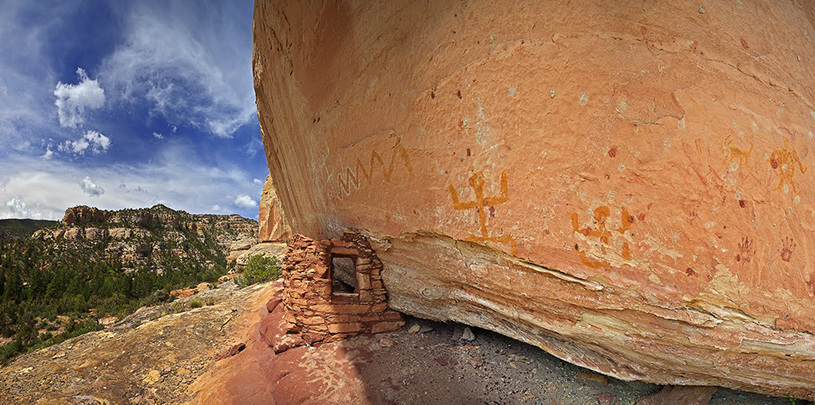
 by Heather Herold, Native America Associate
by Heather Herold, Native America Associate
As summer temperatures rise in the Southwest, the urgency to protect the Bears Ears cultural landscape heats up as well. With the 110-year anniversary of the Antiquities Act on June 8, we are reminded of the reasons why this important legislation was enacted.
In 1906, when looting of cultural sites in the Southwest was rampant, President Theodore Roosevelt signed the Antiquities Act to ensure that archaeological, historic, and scientific resources would receive federal protections. This law made the destruction of sites on federal lands and the removal of artifacts from them punishable by law. And, in a little-noticed clause, it also gave presidents the authority to declare national monuments of historic or scientific interest.
The Antiquities Act represents a milestone in conservation and archaeological protection and remains an invaluable tool today.
“There is a delight in the hardy life of the open. There are no words that can tell the hidden spirit of the wilderness, that can reveal its mystery, its melancholy and its charm. The nation behaves well if it treats the natural resources as assets which it must turn over to the next generation increased and not impaired in value.”
-President Theodore Roosevelt
Looting continues in the Bears Ears region, where over 100,000 archaeological and cultural sites dot the landscape. The Bears Ears region is home to some of the most spectacular and important archaeological resources in the Southwest, including cliff dwellings, great houses, pueblos, shrines, rock shelters, road systems, rock art panels, projectile points, and ceramics. These ancestral lands provide spiritual and cultural sustenance for tribes, as well as a living record of Native American history and identity. Archaeological and cultural sites at Bears Ears, however, are in constant peril and need our help.
“The cultural resources here, the petroglyphs, the structures, all of this, is evidence of the native people who lived in and passed through the Bears Ears. It provides a link to our ancestors, from long ago. This cultural information is important for all native people. This is why tribes have set aside any differences and come together: if this information is lost, it’s lost forever. It is devastating to think of that loss. We must protect Bears Ears”
– Octavius Seowtewa, Zuni Elder
The Bears Ears landscape has seen seven serious looting incidents in the past six months, in addition to two dozen other looting cases in the past five years. The region is currently managed by the Bureau of Land Management and Forest Service, which employ only two law enforcement officers for the area.
Friends of Cedar Mesa, a conservation group located in Bluff, Utah, announced a partnership with these land management agencies in May, offering a $2,500 reward for information leading to the prosecution of looters, vandals, and grave robbers.
The reality in the Bears Ears region is that cultural resources are being violated, destroyed, and threatened by those unable to appreciate their immense importance, not only to Native Americans, but to the story of humanity as a whole.
Bears Ears belongs to all people, as public lands, rather than a shortsighted few. Local people, especially local Native American communities, fully support a national monument designation. The Bears Ears Inter-Tribal Coalition (composed of the Hopi, Navajo, Zuni, Ute Mountain Ute, and Uintah and Ouray Ute governments) is leading the effort to protect the Bears Ears region as a national monument.
As as anthropologist and archaeologist myself, I see the Bears Ears National Monument proposal as a possibility for a new chapter in cultural resource protections.
This is the first time in the history of the Antiquities Act that tribes are petitioning the president for a national monument that honors both the antiquities themselves in the Bears Ears region and the continued cultural use of the landscape.
Few anthropologists and archaeologists would disagree that we need to hear and listen to more Native American voices in cultural resource discussions and decision-making.
The coalition has come together in an unprecedented effort to protect a landscape that is vital to all five tribes in very different ways, demonstrating that genuine collaboration and communication around cultural resource issues is possible and yields powerful results.
We are witnessing history in the making as the coalition asks President Obama for a national monument designation, ushering in a new era of Native American involvement in public lands and cultural resource protections.
You can help honor the legacy of the Antiquities Act and protect the invaluable cultural landscape known as the Bears Ears by joining us in support of the Bears Ears Intertribal Coalition. Sign the petition to President Obama to permanently protect the Bears Ears as a national monument.
A small victory in the legal case challenging Daneros uranium mine, near Bears Ears National Monument.
Read MoreMugs, handmade soaps, high fashion, jewelry and more. There's something for everyone on your holiday shopping list.
Read MoreBears Ears petroglyph panels and cultural sites protected by new proposed management plan.
Read More